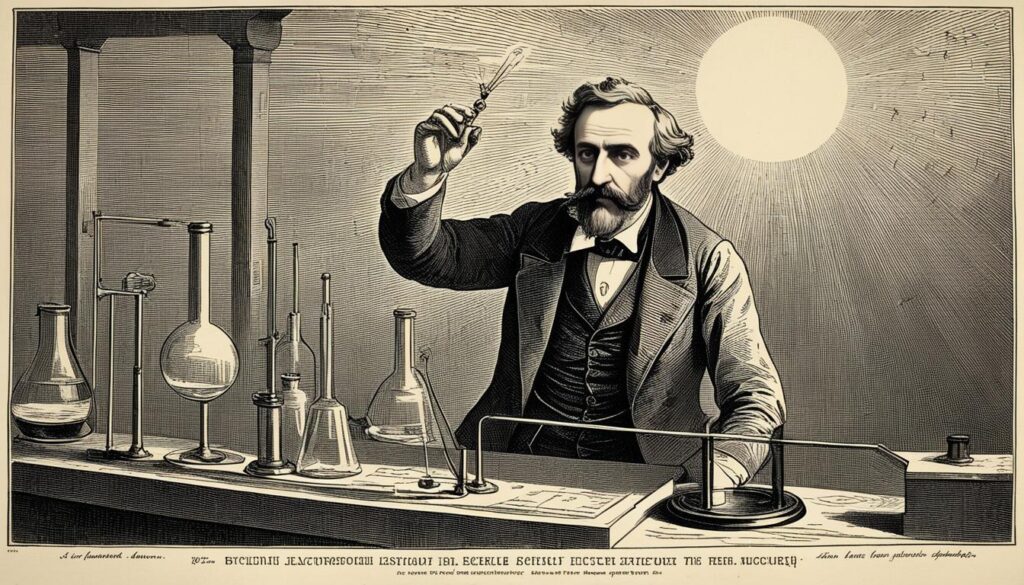Have you ever thought about who really invented the solar panel? And how did this life-changing technology grow over time? Solar energy’s beginnings are filled with amazing stories from centuries ago. Various cultures and people have made key contributions. These all led to where we are now in using the sun’s power.
Solar power plays a big part in clean energy today. It has a long history, starting with using sunlight to make fires in the 7th century B.C. This early step has since evolved into advanced solar PV technology. Work by ancient Chinese, Greeks, and others used solar power for many things. They started from igniting fires to building sunrooms and crafting solar ovens. The question of who first made the solar panel is not simple. People like Edmond Becquerel, Charles Fritts, and the Bell Labs team contributed greatly. Today, solar technology is a key part of renewable energy.
Key Takeaways
- The history of solar energy spans centuries, originating from the use of sunlight with primitive magnifying tools.
- Ancient civilizations including the Chinese, Greeks, and Romans innovatively harnessed solar power for diverse applications.
- Edmond Becquerel’s discovery of the photovoltaic effect marks a pivotal moment in solar energy history.
- Charles Fritts developed the first solar cells using selenium wafers in 1883.
- The modern efficiency of solar panels began with the development of silicon PV cells by Bell Labs in the 1950s.
The Early Use of Solar Energy
The use of solar energy dates back to ancient times. Looking at its history helps us see the early steps towards today’s green tech. It’s amazing how people figured out to capture the sun’s power.
The 7th Century B.C. and Magnifying Glasses
As early as the 7th century B.C., people used magnifying glasses to light fires. This shows ancient folks knew about the sun’s power and used it in daily tasks.
Greek and Roman Contributions
The Greeks and Romans added a lot to solar tech. They made mirrors that focused sunlight to start fires during ceremonies. Romans also built bathhouses with big windows facing south, warming them with sunlight.
Chinese Innovations
In China, mirrors were used in a similar way. They were key in many activities, showing early solar tech skills. Later, the Pueblo people made sunrooms after seeing the Chinese, proving how ideas can span the globe.
| Ancient Civilizations | Solar Energy Innovations | Significance |
|---|---|---|
| 7th Century B.C. | Magnifying glasses | Starting fires |
| Greeks and Romans | Burning mirrors, sunrooms | Religious ceremonies, heating bathhouses |
| Chinese | Mirrors, sunrooms | Various practical applications |
These early uses of solar energy show how humanity has always wanted to use the sun. Learning about solar history gives us a glimpse into past achievements. It also highlights how ancient people helped shape our renewable future.
The Photovoltaic Effect: A Pivotal Discovery
Back in 1839, Edmond Becquerel found a way to turn sunlight into electricity. He noticed that light could make metal and a solution produce electricity. This breakthrough made him a pioneer in creating what we now call photovoltaic cells.

Edmond Becquerel’s Breakthrough
Becquerel placed metal in a special liquid and saw something amazing. When the metal was hit by light, it started making electricity. This was the start of solar technology as we know it. He was one of the early scientists to show that we could change sunlight directly into power.
Willoughby Smith and Selenium’s Photoconductivity
After Becquerel, Willoughby Smith discovered something important about selenium in 1873. He found that selenium could turn light into electricity. With the help of William Grylls Adams and Richard Evans Day, they proved this was possible. This finding was named selenium photoconductivity. It was a big step in understanding how materials could make electricity from light, without needing any movement.
Below is a concise comparison of the key contributions by these pioneering scientists:
| Scientist | Contribution | Year |
|---|---|---|
| Edmond Becquerel | Discovered the photovoltaic effect | 1839 |
| Willoughby Smith | Identified selenium’s photoconductivity | 1873 |
| William Grylls Adams & Richard Evans Day | Proved selenium generates electricity under light | 1876 |
These early discoveries are crucial to how we use solar energy today. They set the foundation for all the new solar technology we see and use. They opened the door to how we turn sunlight into power.
Charles Fritts and the First Solar Cell
Charles Fritts is often called the father of solar panels. In 1883, he crafted the first solar cells from tiny selenium pieces. These early cells were not very efficient when compared to today’s technology. They worked on selenium, which is not the same as the silicon in modern solar panels.
Fritts’ work was a major step in solar panel history. Even with their low efficiency, his cells paved the way for future solar innovations. The switch to using silicon was a big leap forward. It significantly upped solar cells’ efficiency. Still, Fritts’ early work is key in the story of solar technology. It shows how important he was as a solar panel inventor.
| Aspect | Charles Fritts’ Solar Cells | Modern PV Cells |
|---|---|---|
| Material | Selenium | Silicon |
| Efficiency | Less than 1% | 15-20% |
| Initial Invention Year | 1883 | 1954 (Silicon-based by Bell Labs) |
In short, Fritts’ creation of the first solar cells using selenium was a huge deal. His work opened the door to many future discoveries in solar technology. His legacy lives on in the advancements we see in the solar industry today.
The Role of Bell Labs and Modern Solar Panels
Modern solar technology owes a lot to Bell Labs’ pioneering work. It was crucial in developing the silicon cells in today’s solar panels.
Daryl Chapin, Calvin Fuller, and Gerald Pearson
In 1954, Bell Labs made history with the first silicon cell. The scientists, Chapin, Fuller, and Pearson, brought their skills together. This led to more efficient solar cells and started the path to solar power.

The Birth of Silicon-based PV Cells
Bell Labs moved away from selenium to silicon technology. This choice made solar electricity more efficient. It was the first step towards improving solar cell technology.
| Year | Development |
|---|---|
| 1954 | Introduction of the silicon photovoltaic cell by Bell Labs |
| 1960s | Initial use of silicon cells in space applications |
| 1980s | Improvements in silicon cell efficiency and reduction in production costs |
| 2000s | Advances in modern PV technology, making solar panels more affordable |
| Present | Continued innovation, focusing on higher efficiency and sustainable production methods |
Solar Panels in Space
Going into space needs energy we can trust and that works well. Solar technology fits perfectly, its lasting performance key in space missions.
The Vanguard Satellites
In 1958, the Vanguard I satellite showed us the future with solar panels. It was the first in space to use solar technology for power. With only a one-watt solar panel, it proved solar technology in space could work. This was a major step towards more advanced designs, showcasing the rich promise of Vanguard satellites photovoltaics.
NASA’s Nimbus Program
Then came NASA’s Nimus program, pushing solar tech to new heights. Starting in the 1960s, these weather satellites were powered by solar energy. The NASA solar energy systems used by Nimbus satellites were cutting-edge. They could create a lot of power, perfect for long space missions. This success highlighted the durability and adaptability of solar panels in space.
Who Invented the Solar Panel? The Debate
The invention of the solar panel comes from many important steps. Each piece of the puzzle has been vital in the growth of solar technology. These steps have led us to the solar panels we know today.
Edmond Becquerel’s Contribution
In 1839, Edmond Becquerel found a key part of *photovoltaic technology*. He saw that light could create electricity in a solution with metal. This discovery with *Becquerel photovoltaic* marked the start of using sunlight for power.
Charles Fritts’ Selenium Cells
Jump to 1883 and Charles Fritts was using selenium to make solar cells. Though not very efficient today, this was a big step. These *Fritts selenium solar cells* showed us we could turn sunlight into power.
Chapin, Fuller, and Pearson’s Silicon Cells
Bell Labs made a huge move in 1954 with silicon cells by Daryl Chapin, Calvin Fuller, and Gerald Pearson. Their work is often seen as the beginning of modern solar panels. The efficiency of their PV cells was a big deal, showing solar panels at their early best.
| Contributor | Year | Contribution |
|---|---|---|
| Edmond Becquerel | 1839 | Discovery of the photovoltaic effect |
| Charles Fritts | 1883 | Development of the first selenium solar cells |
| Daryl Chapin, Calvin Fuller, Gerald Pearson | 1954 | Creation of silicon photovoltaic cells at Bell Labs |
Solar Energy Milestones in the 20th Century
The 20th century was a big time for solar energy. It brought new and exciting solar devices to life. Scientists and inventors really figured out how to use the sun’s power in cool ways.

Early Solar Collectors and Cookers
Let’s look at how solar collectors began. People like Horace de Saussure and Sir John Herschel started it all. Horace made the first-ever solar oven. Sir John used solar cookers on his trips in Africa. They showed that using the sun to cook was possible and smart.
The Development of Solar Water Heaters
Clarence Kemp changed the game in 1891 with a solar water heater patent. His device used the sun to warm water. It was a smart mix of a normal water tank and a solar energy collector.
This invention made everyone see solar power’s bright future. Over time, these heaters got better and more people started using them. Today, solar energy is part of our daily lives.
The Impact of the Oil Crisis on Solar Energy
The 1970s oil crisis changed how we produce energy. It made us search for new sources to avoid relying too much on oil. This search led to a big push in developing oil crisis solar growth. Governments and companies started investing more in solar power because of the high oil prices. This effort boosted solar energy research funding.
Thanks to this funding, our work on solar technology sped up. Breakthroughs in amorphous silicon and thin-film solar cells were key. These changes made solar panels better and cheaper. People started using them in daily life, not just as experiments.

This time was a turning point for solar power. It began to be seen as a real option for more people. The crisis showed that we needed to take renewable energy seriously. A lot of effort was made to get money for solar energy research funding. This support helped new solar tech get out to people. It laid the foundation for more growth in the future.
Advancements in Solar Technology Efficiency
Solar technology has made huge leaps in efficiency. Thanks to the work of many groups and schools, we’re using solar power better than ever. These improvements make solar energy a key player in our future.
Hoffman Electronics’ Breakthroughs
In the 1950s and 60s, Hoffman Electronics made big improvements. They figured out how to make silicon solar cells better. This lifted cell efficiency from 8% to 14%. Such progress is the foundation for today’s solar technology.
University of New South Wales Achievements
The University of New South Wales (UNSW) is a leader in solar study. In 1989, they crafted a silicon cell that reached 20% efficiency. This was a huge step forward. It showed the world what solar power could do. UNSW continues to set new standards in solar technology.
Modern Efficiency Records

In more recent years, SpectroLab Inc. teamed up with the National Renewable Energy Laboratory. Together, they developed solar cells that are over 24% efficient. These achievements show the bright future of solar technology. They prove that we’re on the right track with solar energy.
| Year | Organization | Efficiency Achieved |
|---|---|---|
| 1950s-60s | Hoffman Electronics | 8% to 14% |
| 1989 | University of New South Wales | 20% |
| 2020s | SpectroLab Inc. | 24%+ |
Conclusion
The story of solar panels is a tale of human creativity and a desire for clean energy. It all started in the 19th century with Edmond Becquerel’s discovery of the photovoltaic effect. Since then, we’ve made huge steps, like the invention of the first silicon PV cells by Bell Labs. Every achievement shows how vital solar energy is for our planet.
Now, we have high-tech photovoltaic cells that are very efficient and effective. People are always working to make solar technology better. This shows how important solar power is for the future of our energy needs. Thanks to places like Hoffman Electronics and the University of New South Wales, we have a bright future with solar energy.
Looking from the past to now, the growth in solar power isn’t just about cool gadgets. It’s our way of keeping the Earth healthy for the future. Solar panels help us lower our carbon footprint and fight climate change. They are a key part of our plan for a greener world.




Just read this Who Invented the Solar Panel? piece. Cool history, but Im thinking, what if it was aliens who actually gave us solar tech? I mean, ancient Greeks and Romans were advanced, sure, but solar energy? Maybe they had extraterrestrial help. Crazy idea, I know, but makes you wonder, right?
Interesting read! But isnt it ironic that we credit the ancient Greeks and Romans for their solar innovations, yet it took us till the mid 20th century to invent the solar panel? Makes you wonder what other ancient technologies weve overlooked or simply forgotten to credit. Just some food for thought!
Wow, can you believe the early use of solar energy dates back to the 7th century B.C.? The Greek and Roman contributions are mind-blowing! Makes you wonder what other ancient technologies were not aware of.
Actually, ancient civilizations were more advanced than we give them credit for. Its fascinating!
Wow, the history of solar panels is so intriguing! Do you think the ancient Greeks and Romans get enough credit for their contributions to solar energy? I feel like they were way ahead of their time!
Interesting read, but ever wondered if ancient civilizations other than Greeks and Romans mightve harnessed solar energy? Aliens maybe? Just a wild thought!
Interesting read, but ever thought the Greeks and Romans might have borrowed solar tech from even older, lost civilizations? #AncientAliens?
Interesting theory, but without solid proof, its just a romanticized myth. #HistoricalFactsMatter
Interesting read but shouldnt we credit the sun itself for inventing solar power? After all, isnt nature the greatest inventor? Just a thought.
Interesting read! But wasnt the photovoltaic effect discovered by Becquerel, not the Greeks or Romans? Lets give credit where its due.
Interesting read! But did any African civilizations contribute to early solar tech? Seems were only focused on Greek and Roman contributions.
Intriguing read! Though, isnt it fair to mention how Teslas tech advancements have modernized solar panels? Just a thought.